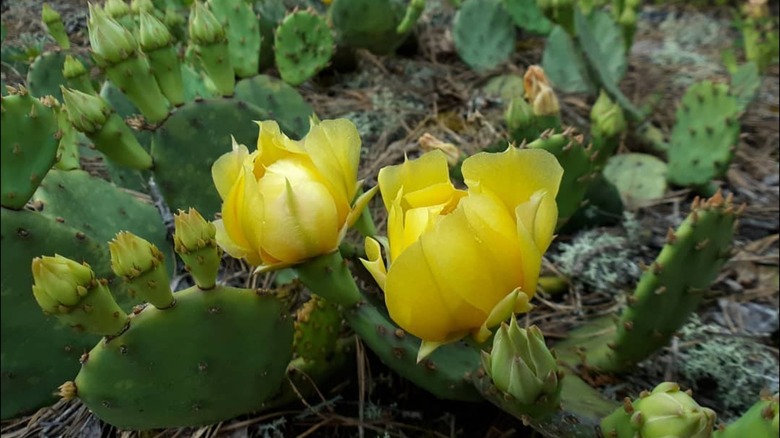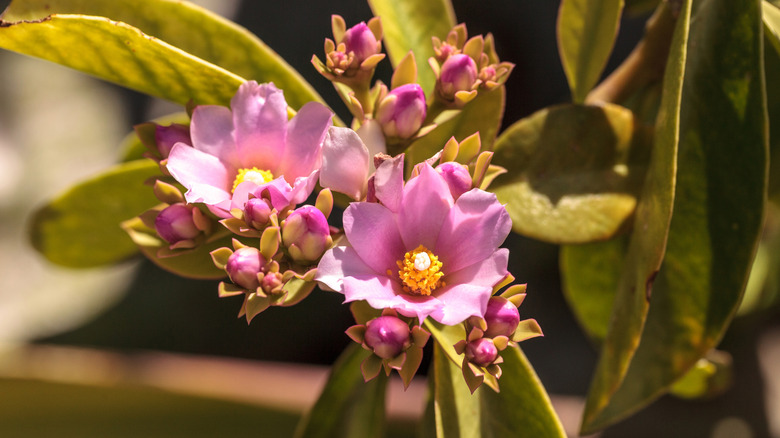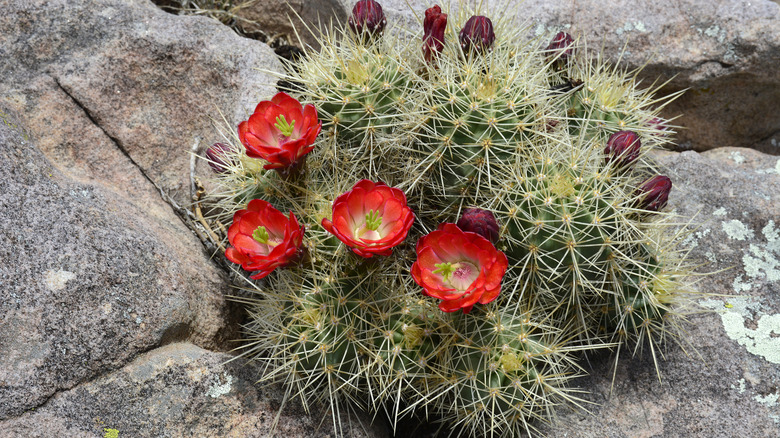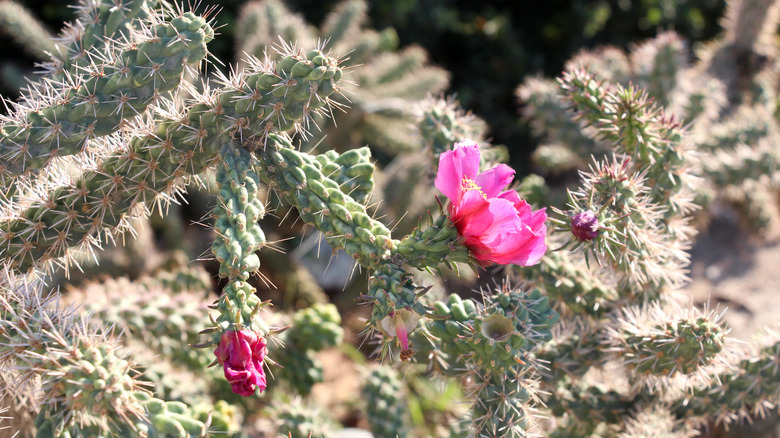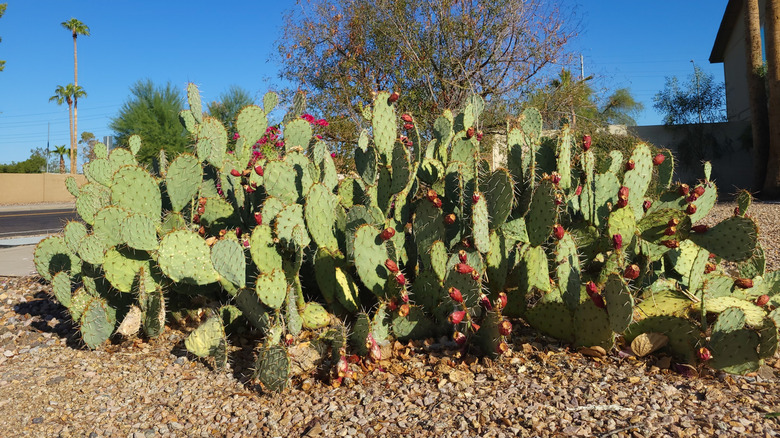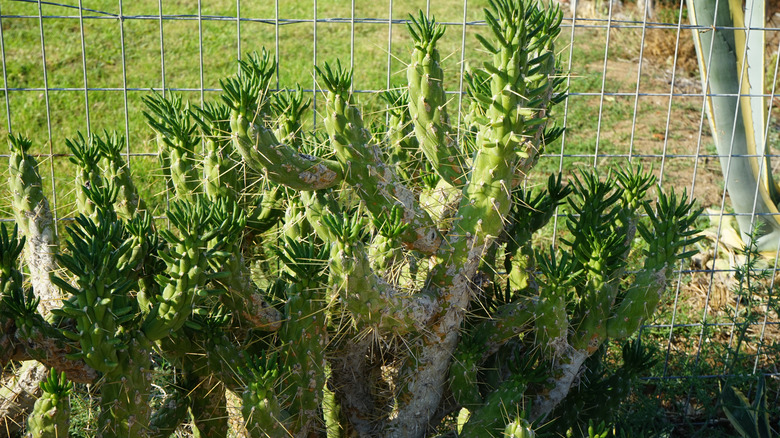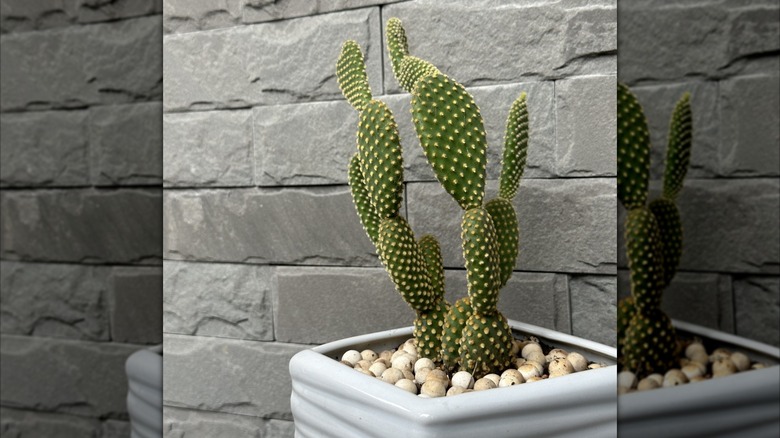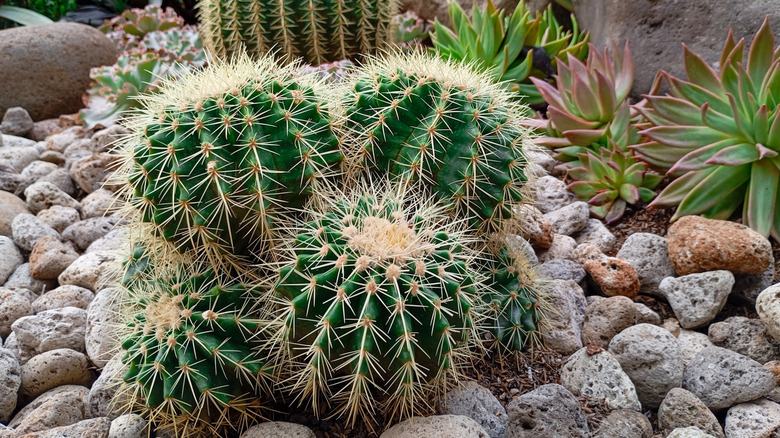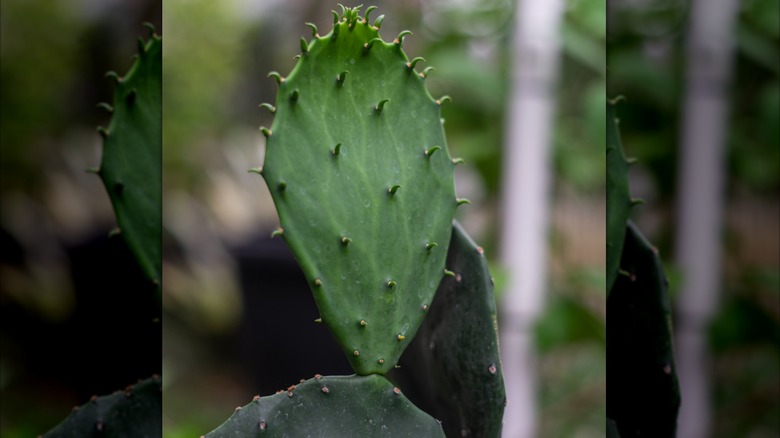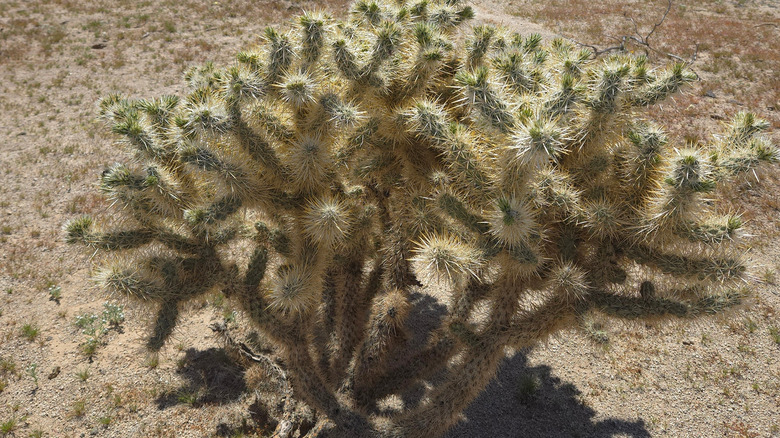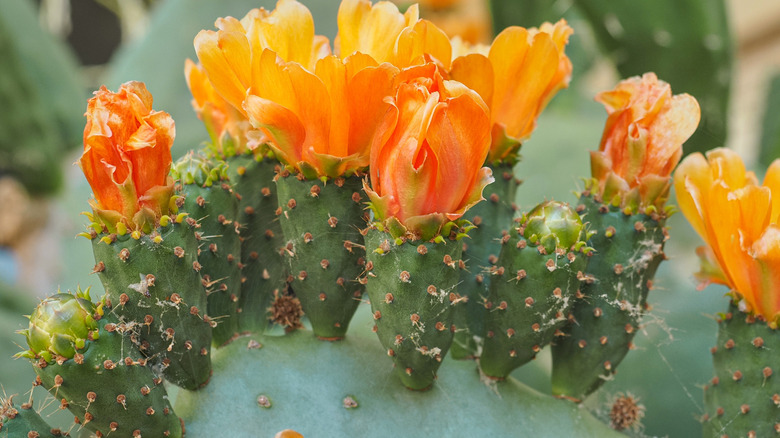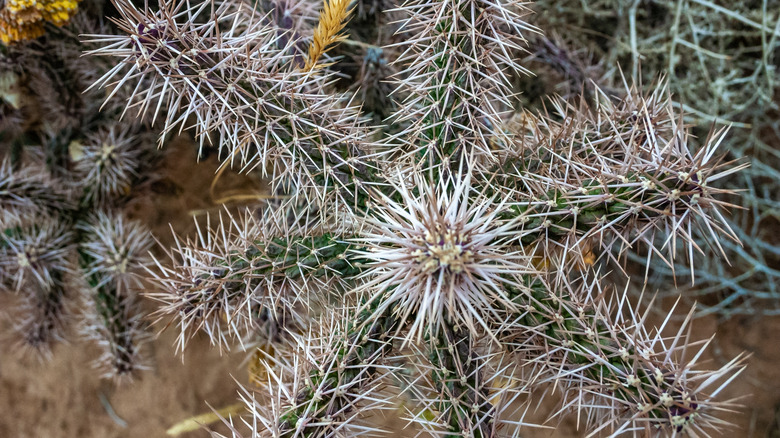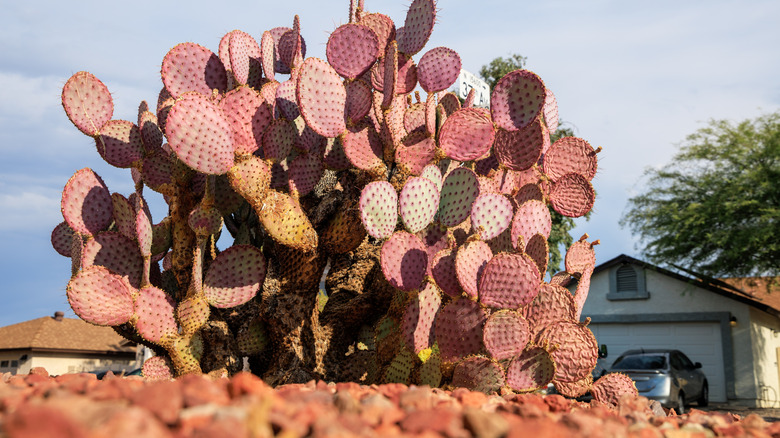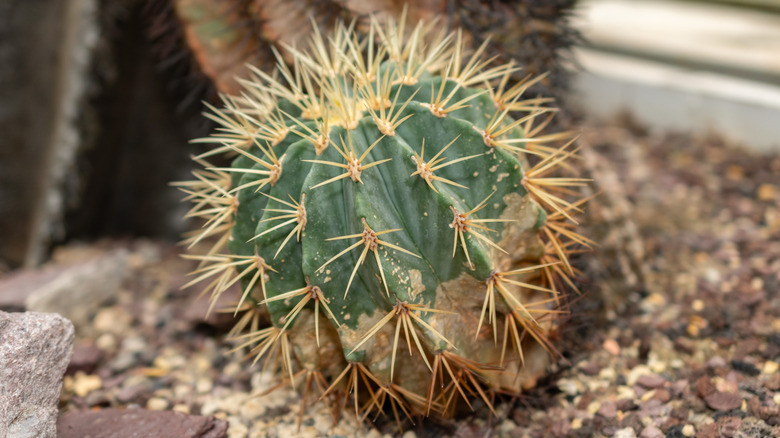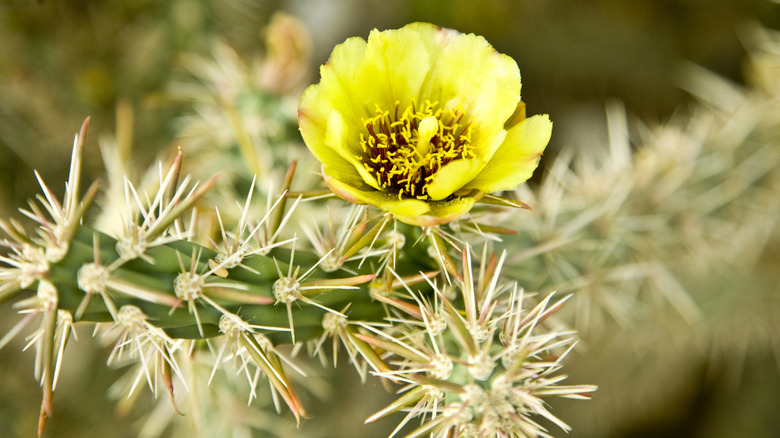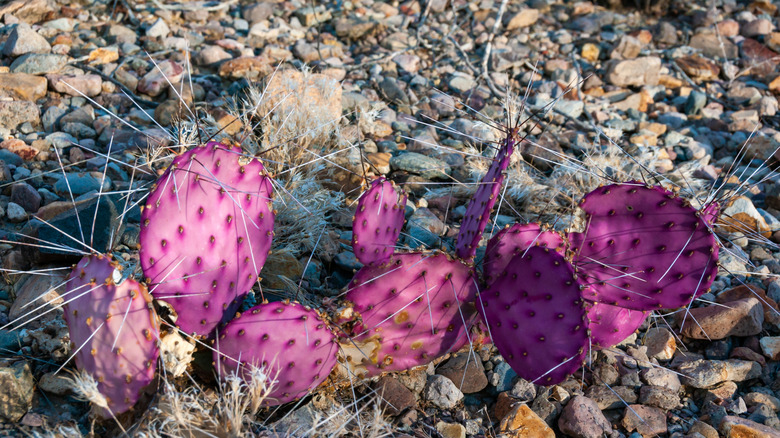16 Types Of Cacti To Grow Around Your Home For Extra Security
When it comes to home security, more is less. While you would obviously secure your property's vulnerable points with smart security systems, supplementing it with strategic landscaping can further bolster your defenses. To achieve that, you must look for thorny, prickled, barbed, or spiky plants that emanate strong go-away-or-get-hurt energy with their sharp lines and protrusions. And frankly, nothing tops cacti in that department. Although cacti developed their slew of spines and bristles to minimize evaporation loss in arid climates and defend against thirsty animals, these features can be tapped into to give opportunistic intruders a pause. Chances are they'll reconsider and not risk walking through prickly pear cacti or jumping on cholla trees to save themselves the pain and tears. Moreover, it helps that cacti produce gorgeous blooms, generating ornamental interest, in addition to adding textural contrast with their sculpturally shaped stem pads.
However, as cacti thorns cannot differentiate between friends and foes (and, least of all, your furry friends), you must be careful about their location and size. Best pop these thorny plants around entry points, such as walls, fences, screens, and windows. Alternatively, plant them en-masse to create knee-level security hedges. Choose shorter plants as they won't block sight lines and are easier to prune (when required). As a final step, check your HOA guidelines for any planting restrictions. With your preferences in place, read on to learn about the different cactus varieties you can grow around your perimeter for additional security.
1. Southeastern prickly pear
Consider growing a prickly pear cactus next to your windows, especially its variety of southeastern prickly pear (Opuntia mesacantha). Since these plants don't grow taller than 3 feet, they're unlikely to impede escape in a fire event. However, they're great at warding off any troublemakers as they flaunt both hair-like bristles and long spines. These puncture through the skin, causing contact dermatitis, and are tedious to get out once in. Southeastern prickly pear plants thrive in arid climates with full sun exposure. They're pollinator-friendly, with birds and bees feasting on their red berries and spring flowers.
2. Rose cactus
Despite hanging out in the Cactaceae family, the rose cactus (Pereskia grandiflora) behaves more like a shrub or a small tree, standing over 6 feet tall and wide with its band of green leaves. For this reason, it's often trained over a trellis or grown into a security hedge where its long, black spines function as a deterrent. Typically, an evergreen rose cactus sheds its leaves when mercury dips below 50 degrees Fahrenheit but remains cold-hardy to 25 degrees Fahrenheit. Position it in the site receiving morning sun. Birds may gorge on its pear-shaped fruits growing in the summer.
3. Claret cup cactus
Colorado's state flower, claret cup or kingcup cactus (Echinocereus triglochidiatus), can bolster your home security through its wicked web of grayish-white (sometimes black) radial and central spines. Some of these spines are also present on its fleshy fruits. As such, the claret cup cactus is quite ornamental, especially when its 4-foot-wide cylindrical mound is smothered by tubular reddish-orange flowers — even hummingbirds can't resist stuffing their tongues in them. Give them at least six hours of direct sun exposure. Considering their minimal watering requirements and drought and heat tolerance, they can serve as your gateway to jumping on the xeriscaping trend.
4. Cane cholla
Alternatively popular as walkingstick or tree cholla, cane cholla (Cylindropuntia imbricata) is another barrier plant worth your consideration. Atop its 8-foot frame, you'll find scores of silverish-yellow or brown spines protruding from its areoles (bumps), which can hurt (even deer are aware of this). Surprisingly, they're cold-hardy, tolerating dips to –20 degrees Fahrenheit. Another perk? They add immense wildlife value. Birds quickly turn their braided stems into nests while nibbling on their yellow fruit. Bees and beneficial insects flutter about their pink flowers for nectar. Give them full sun, though they don't mind a little shade.
5. Tulip prickly pear
To deter animals from treating it as a water reservoir, tulip prickly pear (Opuntia phaeacantha) developed glochids and spines as weighty defense mechanisms. Fortunately, these are equally injurious to burglars, piercing through their skin and leaving them scratching all over. That's what makes them one of the best plants to use to create a private patio space. That they grow 8 feet tall and across helps, too. Otherwise, pop prickly pear in sunny sites with rocky or sandy soils (and forget them if your area receives occasional rainfall). Hummingbirds and pollinators will visit their golden flowers in spring.
6. Eve's needle cactus
Eve's needle cactus (Austrocylindropuntia subulata) packs a painful punch thanks to its 3-inch-long grayish-white spines, proudly pushing out through the white outgrowths on lustrous stems. That's also how these desert plants deter bunnies from turning them into tasty morsels, though small mammals and birds will gladly harbor in their evergreen foliage. Since Eve's needle doesn't tolerate freezes or humidity, it's only suitable for arid climates. However, position it in slightly shaded areas, or its leaves will burn. Low maintenance and easy to grow, these cactus plants sustain in dry, impoverished soils. Some varieties may grow 13 feet high.
7. Bunny ears cactus
Unlike their cute name and shape, bunny ears cactus (Opuntia microdasys) act anything but cute with trespassers. Their green pads rock russet, yellow, or white barbed, hair-like bristles (glochids) in their white bumps that detach on mere contact, reducing intruders to a sorry figure. Their gorgeous burgundy red berries support glochids after they ripen in summer, though they're edible. So, you can match security with edibility, but put your gloves to stave off skin irritation. Bunny ears cactus top out at 3 feet and won't block sight lines. However, they love to sprawl as they mature, so keep them potted.
8. Golden barrel cactus
Golden barrel cactus (Kroenleinia grusonii) is a low-maintenance, evergreen perennial you can grow for textural accent as well as security in a window box. Starting as a rounded barrel, it eventually extends 2½ feet wide and slightly taller, festooned with yellow flowers and brown fruits in the growth season. However, you're unlikely to notice them since they're often overshadowed by the mass of similarly-colored sharp spines. Despite being a desert plant, it cannot survive intense heat and is best grown in sunny to partially shaded spots in areas experiencing upwards of 115 degrees Fahrenheit.
9. Old Mexico prickly pear
Want to recreate the feel of an old Western movie yet meet your security goals? Plant old Mexico prickly pear (Opuntia gomei) so that you can enjoy its rounded, fleshy green pads that burst into mostly yellow blooms in late spring. As old Mexico prickly pear can grow over 4 feet wide, you must give it ample room to grow in a sunny location. Be prepared to prune its pad segments that notoriously droop under their weight and root where they drop on the ground.
10. Teddy bear cactus
Native to the southwest U.S., the teddy bear cactus (Cylindropuntia bigelovii) is another evergreen tree-like plant that you may use to upgrade your home security. It typically grows about 3 feet tall and can be positioned next to the fence. Or, team it with barrel cactus for a stronger message. Don't be fooled by this cactus' fuzzy demeanor because those white protrusions are actually spines that detach easily and will cling to any intruder, causing painful sores. It prefers sunny sites where temperatures remain above 50 degrees Fahrenheit. Teddy bear cactus tolerates dry, rocky soils without raising its watering demands.
11. Texas prickly pear
Texas prickly pear (Opuntia engelmannii) showcases varying growth patterns across its myriad varieties, from tree-like and upright to spreading. Even its bee-friendly flowers are highly variable, showing up as orange or chartreuse in different locations. Irrespective of the variety, all Texas prickly pear cacti bear mean spines and glochids, certain to painfully cleave into the skin. They're also low maintenance, forsaking any irrigation demands despite being sited in full sun conditions. However, you might've to prune their pads occasionally to stem their advances and prevent overcrowding, or they may suffer root rot or scale infestations.
12. Jumping cholla
Jumping cholla (Cylindropuntia fulgida) may not produce gorgeous flowers like its cacti brethren. But it packs a massive punch on the security front with its mass of barbed spines framing its 8-foot-tall physique. These silverish-yellow spines embed so deeply into the skin that the accompanying stem comes free of the shrub with movement. This way, the cactus ensures its spread. Jumping cholla doesn't require any irrigation after establishment. So, ensure its site drains well, or the roots will rot. Gardeners may enjoy its hanging fruit chains that persist through the years.
13. Santa Rita prickly pear
Pretty up your home landscape with Santa Rita prickly pear (Opuntia santa-rita), provided the winter temperatures don't slide below 25 degrees Fahrenheit. This 8-foot-wide shrub (and nearly as tall) grows deep purple in cold weather, toning down to softer blues during summers. While it can do without watering, it may require a session or two during severe droughts — you can tell it's stressed from its red pads. Unlike its counterparts, Santa Rita doesn't support many spines. Instead, it relies on fairly short, hair-like bristles to warn off notorious elements. Hose it down regularly to eliminate scales.
14. Monk's hood
Reaching nearly 6 feet in height, monk's hood (Astrophytum ornatum) is the biggest star cactus variety. Keeping with its name, it produces a set of around five stems that twist radially, giving it a star-like appearance from above. Since its body is crisscrossed with white scales that render sunlight protection and minimize transpiration, it can withstand full sun exposure. Monk's hood sets nearly 2-inch-long curvy spines that can be hard to dislodge once they tear through the skin. In the ground, it bears occasional dips to 41 degrees Fahrenheit but fares poorly against light frosts without protection.
15. Pencil cholla
Around busy areas, consider growing pencil cholla (Cylindropuntia arbuscula). That's because its reddish-brown spines and yellow glochids are usually short and aren't as painful to get out but are imposing, nonetheless. As pencil cholla plants can tower 7 feet high and just as wide by maturity, they need plenty of space to mushroom well. They're fairly easy to maintain, as they can do without irrigation and pruning. But if you wish to curtail their spread, remove their pads intermittently. This will also open the plant, keeping scales at bay. Also, ensure they receive full sun exposure.
16. Long-spined prickly pear
Theoretically, long-spined prickly pear (Opuntia macrocentra) could purple-pass for Santa Rita, as they exhibit similar pad characteristics and cold hardiness levels. Though, they're far more ornamental when in bloom, as their yellow flowers show red throats. However, unlike Santa Rita, their glochid production slows down when exposed to slight shade. So, give them six hours of direct sunlight. Since their 3-inch-long bristles are twisted backward, they're arduous to remove once wedged into the skin. While this may deter intruders, it also implies you must ditch pruning plans or carry them out wearing PPE.

